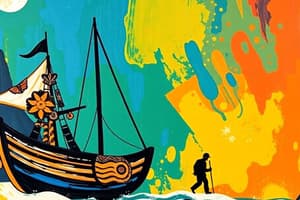Podcast
Questions and Answers
What perspective did Pigafetta notably exhibit in his writings?
What perspective did Pigafetta notably exhibit in his writings?
- A 16th century European perspective (correct)
- An objective view of indigenous cultures
- A critique of European expansionism
- A romantic view of tropical climates
How did Pigafetta perceive the clothing of indigenous people?
How did Pigafetta perceive the clothing of indigenous people?
- As a sign of their nakedness and inferiority (correct)
- As elaborate and suitable for the climate
- As a reflection of their wealth and status
- As indicative of their sophisticated culture
What economic system influenced Pigafetta's observations about wealth?
What economic system influenced Pigafetta's observations about wealth?
- Feudalism, based on land ownership
- Socialism, emphasizing wealth distribution
- Capitalism, focused on trade and investment
- Mercantilism, centered on precious metals (correct)
Which material did Pigafetta underestimate in terms of its appropriateness for housing in tropical climates?
Which material did Pigafetta underestimate in terms of its appropriateness for housing in tropical climates?
What did Pigafetta consistently highlight about the indigenous islands?
What did Pigafetta consistently highlight about the indigenous islands?
Flashcards are hidden until you start studying
Study Notes
Antonio Pigafetta and His Account
- Antonio Pigafetta documented Ferdinand Magellan's voyage, aiming to expand the Spanish empire.
- His writings provide insights into the indigenous people, geography, and climate of the regions visited.
- Pigafetta approached his observations from a 16th-century European perspective, viewing cultures outside Europe as inferior.
European Perspective on Indigenous Peoples
- Indigenous people were seen as lacking civilization, with emphasis on their nakedness and illiteracy.
- Pigafetta expressed admiration for European technology, such as artillery and goods, contrasting it with indigenous practices.
- His views on clothing ignored the practicality of traditional attire in tropical climates, which often prioritized comfort and airflow.
Cultural and Economic Context
- The 16th-century European society was predominantly Christian, considering other beliefs to be blasphemous or barbaric.
- Mercantilism defined the economic landscape, with wealth measured by gold and silver accumulation.
- Pigafetta frequently noted the presence of gold in the islands, reflecting European desires for valuable resources like gold and spices.
Implications of His Observations
- Pigafetta's observations highlighted the broader European mindset focused on domination and exploitation of new territories.
- The European perspective on wealth and culture significantly influenced their interactions with indigenous populations.
- The contrast between Pigafetta's views and the local understanding of resources illustrates the cultural disconnect present during these encounters.
Studying That Suits You
Use AI to generate personalized quizzes and flashcards to suit your learning preferences.




